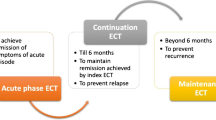Abstract
Electroconvulsive therapy (ECT) is used predominantly to treat major depressive illness but has also been used for chronic pain. ECT causes a variety of neurochemical and neurophysiologic effects, some of which may interact with the pathophysiologic mechanisms in complex pain states. An extensive literature on the use of ECT in pain patients identifies subgroups for whom ECT may result in substantial pain relief. In this article, we review the literature on the use of ECT in pain patients, suggest possible neurobiologic bases for the efficacy of ECT in such patients, and conclude with our recommendations for current clinical practice.
Similar content being viewed by others
References and Recommended Reading
American Psychiatric Association Committee on Electroconvulsive Therapy: The Practice of Electroconvulsive Therapy: Recommendations for Treatment, Training, and Privileging, edn 2. Washington, D.C.: American Psychiatric Association; 2001. Represents the standard of care in current ECT practice.
Pisetsky JE: Disappearance of painful phantom limbs after electric shock treatment. Am J Psychiatry 1946, 102:599–601.
De Gutierrez-MahoneyCG: The treatment of painful phantom limb by removal of post-central cortex. J Neurosurg 1949, 1:156–162.
Bornstein B: Sur le phenomene du membrane fantome. L’Encephale 1949, 38:32–46.
Hohman LB, Wilkinson WE: Pain equivalents treated with electroshock. US Armed Forces Med J 1953, 7:1025–1029.
Boyd DA: Electric shock therapy in atypical pain syndromes. Lancet 1956, 76:22–25.
Weiss DM, Bloomberg W, Drew JH: The use of electroshock as therapy for atypical and intractable pain. Trans Am Neurol Assoc 1957, 82:166–168.
Von HagenKO: Chronic intolerable pain. Discussion of its mechanisms and report of eight cases treated with electroshock. JAMA 1957, 165:773–777.
Weinstein EA, Kahn RL, Bergman PS: Effect of electroconvulsive therapy on intractable pain. Arch Neurol Psychiatry 1959, 81:37–42.
Bradley JJ: Severe localized pain associated with the depressive syndrome. Br J Psychiatry 1963, 109:741–745.
Mandel MR: Electroconvulsive therapy for chronic pain associated with depression. Am J Psychiatry 1975, 132:632–636.
Salmon JB, Hanna MH, Williams M, et al.: Thalamic pain—the effect of electroconvulsive therapy (ECT). Pain 1988, 33:67–71.
Hampf G, Kuoppasalmi K, Henrikson M, et al.: Chronic facial pain together with severe depression is responsive to electroconvulsive therapy. A case report. Acta Odontol Scand 1992, 50:129–132.
King JH, Nuss S: Reflex sympathetic dystrophy treated by electroconvulsive therapy: intractable pain, depression, and bilateral electrode ECT. Pain 1993, 55:393–396.
Bloomstein JR, Rummans TA, Maruta T, et al.: The use of electroconvulsive therapy in pain patients. Psychosomatics 1996, 37:374–379.
McCance S, Hawton K, Brighouse D, et al.: Does electroconvulsive therapy (ECT) have any role in the management of intractable thalamic pain? Pain 1996, 68:129–131.
Hoshimo T, Sakamoto A, Suzuki N, et al.: Electroconvulsive therapy for the depressed patients associated with chronic pain. Masui 1999, 48:763–766.
Rasmussen KG, Rummans TA: Electroconvulsive therapy for phantom limb pain. Pain 2000, 85:297–299. Provides data on how ECT may have a primary benefit for phantom limb pain.
Abrams R: Electroconvulsive Therapy, edn 3. New York: Oxford University Press; 1997.
Tortella FC, Long JB, Hong J-S, et al.: Modulation of endogenous opioid systems by electroconvulsive shock. Convulsive Ther 1989, 5:261–273.
Holaday JW, Tortella FC, Long JB, et al.: Endogenous opioids and their receptors: evidence for involvement in the postictal effects of electroconvulsive shock. Ann N Y Acad Sci 1986, 462:124–139.
Alexopoulas GS, Inturrisi CE, Lipman R, et al.: Plasma immunoreactive beta-endorphin levels in depression. Effect of electroconvulsive therapy. Arch Gen Psychiatry 1983, 40:181–183.
Ghadirian AM, Gianoulakis C, Nair NPV: The effect of electroconvulsive therapy on endorphins in depression. Biol Psychiatry 1988, 23:459–464.
Young EA, Grunhaus L, Haskett RF, et al.: Heterogeneity in the beta-endorphin immunoreactivity response to electroconvulsive therapy. Arch Gen Psychiatry 1991, 48:534–539.
Weizman A, Gil-Ad I, Grupper D, et al.: The effect of acute and repeated electroconvulsive treatment on plasma beta-endorphin, growth hormone, prolactin and cortisol secretion in depressed patients. Psychopharmacology 1987, 93:122–126.
Freeman W, Watts JW: Pain of organic disease relieved by prefrontal lobotomy. Lancet 1946, 29:953–955.
Grantham EG, Spurling RG: Selective lobotomy in the treatment of intractable pain. Ann Surg 1953, 137:602–608.
Walker AE: Pain—the neurosurgeon’s viewpoint. J Chronic Dis 1955, 2:91–95.
Nobler MS, Sackeim HA, Prohovnik I, et al.: Regional cerebral blood flow in mood disorders, III: treatment and clinical response. Arch Gen Psychiatry 1994, 51:884–897.
Nobler MS, Sackeim HA, Solomou M, et al.: EEG manifestations during ECT: effects of electrode placement and stimulus intensity. Biol Psychiatry 1993, 34:321–330.
Author information
Authors and Affiliations
Rights and permissions
About this article
Cite this article
Rasmussen, K.G., Rummans, T.A. Electroconvulsive therapy in the management of chronic pain. Current Science Inc 6, 17–22 (2002). https://doi.org/10.1007/s11916-002-0019-4
Issue Date:
DOI: https://doi.org/10.1007/s11916-002-0019-4




